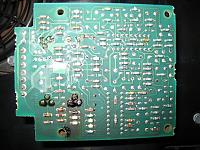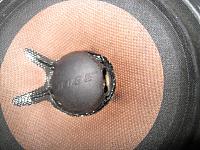What I don't understand: why are the cars rusting that much in the UK?
What I don't understand: why are the cars rusting that much in the UK?
Salted winter roads and the fact that a large portion of NSX were/are used year round.
Senninha
'Too many manufacturers today are obsessed with lap times and power outputs at the expense of emotion and fun' Colin Goodwin
S2 is signed by the NSX Project Leader Shigeru Uehara
Hmmm... normal washing is not going to get any water to the underside of the car though. The brakes will suffer a bit, maybe light surface rusting, and worse case pads rusting to discs but this is rarely a major problem. Of course you should take a short post wash run to air dry all the hard to reach bits.
Unless you mean driven occassionally in foul weather on wet, dirty, salted roads, then quickly washed over with a bucket and sponge and immediately put in the darage still wet... unlikely that anyone here is mad enough to do that
The main problem is, IMHO, regular winter use on our wet, dirty, salty roads. That will bollocks up the underside components of any car
Some of the pics on Prime of the undersides of 10+yr old cars, with reasonable milaeges on them, from dry states like California and Arizona are amazing, they look new!
Cheers
Mark
One thing I noticed on UK based NSX is that quite lots of them showed the similar rusty brackets/bolts under the body of NSX kept close to the coast area of Japan. In Japan, they don't use rock salt on the road during winter but still gets lots of rust if it was kept close to the coast.
When I moved to UK, I started to wash NSX almost every weekend during winter and then in the Spring, put the car on the stand, remove all four wheels and jet wash the underbody really well. Although I drive my NSX every day even in the winter, after doing this for more than 10 years in UK, it seems to be helping the condition of the brackets and the bolts compared to doing nothing (I just hope...)
I heard that some of the European countries use de-icer spray or brine water instead of gritting. Would be interested to know the effect on NSX compared to the gritting.
Regards,
Kaz
Kaz any reason why the NSX brackets, bolts, and some exhausts bits were not made out of a Stainless Alloy? Just curious as everything seems to be so well planned that I can't think of cost been the reason.
I'll await Kaz' answer, but I suspect cost WOULD have been the reason:-
- Alloy arms, brackets, bolts etc. would have been a lot more expensive than ordinary pressed steel, and for a part that no-one would see or care about (until a decade down the road...and what mfr cares about their cars 10 years on?!?)
- Galvanising all those (steel) parts would also have added substantial cost.
...and I strongly suspect the NSX wasn't a profit-maker for Honda, rather a prestige, loss-making 'halo' car.
"No man with a good car needs to be justified"
Blue '08 FD2 CTR - big, ITR-sized shoes to fill...
Yellow '96 NSX 3.0 - oh was it worth the wait!
Black '99 ITR - well, I had to have another one, the first was so much fun. Miss this one even more than #1...
Blue '03 S2000 - SOLD, flawed but fun
Blue '04 Focus TDCi Sport - SOLD, very good fun for a diesel!
Black '00 ITR - SOLD, still missed
Red '98 Civic VTi - SOLD, probably still bombproof
Well all suspension arms are alloy, most suspension bolts are either heavily galvanized or some special metal as they seem to not be corroded.
I've read on Prime Honda lost $18K on every NSX sold?
There are parts such as the bonnet catch that should have been better protected.
Cheers
AR
If you are considering about using stainless for bolts and nuts, you need to be very careful on the selection of stainless material especially if you are using it anywhere close to the source of heat, vibration, etc like on our super NSX.
This is related to the material engineering and I only studied this for a short period so please correct me if I made any mistakes.
Almost every owner knows that most of the parts on our NSX were made from aluminium. However, not everyone knows that there are several different aluminium spec were used depending on the design, strength, purpose and so on.
This is the same for the stainless material. There are several different spec within stainless family such as Austenite (SUS304, 310, etc), Ferrite (SUS430), Martensite (SUS403, 410, etc) and so on.
The golden rule is never use the same stainless material for the nuts and bolts especially around the exhaust area. This is one of the reason why stainless material was not used.
Sometimes, I noticed that owners were using stainless bolts and nuts when installing the aftermarket headers/exhausts and causing lots of headache for the people working on the car later.
Most of the stainless bolts and nuts from aftermarket car parts shop are made from SUS304 and using this on both the bolt and nut are NO - NO.
100% guaranteed to seize or weld together. You must use at least different stainless spec such as Ferrite bolt and Austenite nut.
This is one of the reason why I normally don’t work on header/exhaust without having spare O2 sensor. The gasket of O2 sensor is made from Ferrite stainless and although the header is made from Ferrite or Austenite, quite often the threaded boss for the O2 sensor is also made from Ferrite.
Thus, it is so easy to seize if tiny amount of thread compound was not used on assembly as some of the O2 sensor manufactures don’t recommend using it.
It is very important to use OEM nut and stud for the assembly of header to the engine head for the above reason. They are specially treated to prevent them from seizing.
Other points to consider are the characteristic of stainless, the cost, the purpose and so on.
Most commonly used SUS304 has high thermal expansion rate so you need to be careful on where to use. This is why we have accordion type tube in the middle of header and also using the round shape gasket with spring loaded bolts for each connection.
For production car, it is easier and cheaper to break and replace the nuts and bolts than using stainless material especially around the heatshield/header/exhaust area. As it states, it is stain (rust) less and not complete stain (rust) prevention so after long years with heat, vibration and etc, even the stainless material won't survive.
Hope this will answer part of your question.
Regards,
Kaz
Season’s greetings, everyone. Hope you are having wonderful time over this holiday period and wishing you a successful year for 2010.
Before Christmas, I started to work on another NSX and originally, we planed to carry out the alignment service as well. However, due to the heavy snow forecast, we decided to skip any services requiring alignment work afterwards. Good call as even the alignment shop people couldn’t make it to their office and they are now closed until the New Year.
1. Bose Speaker and Amplifier
During the Health Check Service, we found that there was no sound from the Centre speaker (between the two seats), nor from the passenger Foot well one.
The owner investigated further and he found that someone disconnected the connector to the Centre speaker. The owner also kindly removed the Foot well speaker box before leaving the car at my place.

When I opened the speaker box, immediately I noticed strong smell of burnt circuit board. As seen on several Bose Amps in the past, one of the FET was burnt and damaged other surface mounted parts. Also, there was a trace of someone already worked on the circuit board previously.
Instead of trying to repair the burnt board, decision was made to replace it with my refurbished spare Bose Rear Amp. So, the new amp was installed and the sound test was carried out.
We now got the sound from the Centre speaker but not from the Foot well one….
After some investigation, I found this….

There was a damage/burn on the actual speaker. I was already using spare Foot well speaker on my bench system which was provided from the member ‘mutley’ a while ago.
And with the support from another member ‘328’ who will be providing me with another spare Bose speakers, I managed to use my bench speaker to replace the broken one.
I would like to say thank you to ‘mutley’ and ‘328’ for their support.
Also, I would like to say thank you to ‘forumadmin’ who provided me with his broken amp. It will be used to source some of the parts for the future services.
The owner already replaced the door speaker amps in the past so now we have nice deep bass with surround ‘like’ effect using 4 speakers and 3 amps.